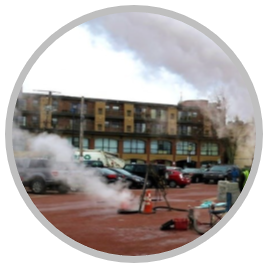Investigation Spotlight: Cure-in-Place Piping
 Problem
Problem
Cure-in-Place Piping (CIPP) is now used widely throughout the country to repair sewer, storm drains and residential applications. CIPP does not require digging trenches to repair a pipeline that is leaking or structurally damaged. CIPP involves inserting a lining within the existing pipe that is damaged. The liner contains a chemical resin which is exposed to a “curing element” that makes the resin attach to the inner walls of the pipe. When the resin is fully “cured” the lining serves as a new pipeline.
CIPP can result in harmful chemical releases. The most widely used resins in are styrene based, which is a toxic volatile chemical. Studies have found that other volatile chemicals also can be released during CIPP installations. These chemicals can travel during and after CIPP installation into indoor air of buildings through windows, doors, cracks in foundations, plumbing and other means, resulting in potentially harmful exposures to occupants.
Investigation
Starting in 2020, the California Department of Public Health (CDPH) began to evaluate reports of multiple incidents of exposures and illnesses among building occupants that occurred after sewer and water pipeline projects used CIPP. In some cases, harmful chemical vapors traveled through the piping and into buildings for up to several months after completion of a CIPP project.
CDPH also learned that some measures that are used by CIPP installers to try to prevent the spread of chemical vapors are not always effective. Additionally, the “four-gas meters” used by First Responders are ineffective at identifying CIPP emissions. Finally, impacted individuals are often directed to call the CIPP contractor with health concerns. Health officials are not informed during or after exposure incidents.
Outcomes and impact
CDPH prepared a
factsheet on Cure-in-Place Piping (CIPP) (pdf) to raise awareness of the risks to the public associated with CIPP installation.
There are insufficient standards/regulations in place to protect the public from harmful chemical releases associated with CIPP installation. In the factsheet, CDPH recommends notifications and emission control practices to reduce the likelihood of harmful exposures from CIPP installation projects.
Resources